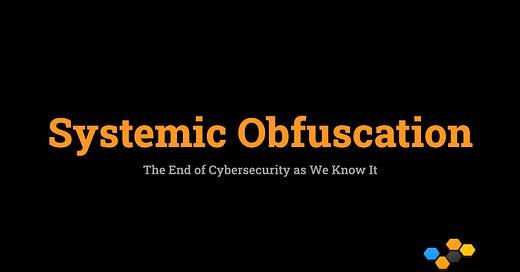Table of Contents
Introduction: The Unwinnable Arms Race
The Flaw in Our Fortress Mentality
A New Foundation - From Defense to Resilience
Elevating the Level of Abstraction
Concept Working Today (That Few Are Doing Right): True Zero Trust
Novel Concept for the Future: "Systemic Obfuscation"
What This Means for Your Business Strategy
Creativity Triggers for Novel Cybersecurity Concepts
Conclusion: Stop Building Walls, Start Changing the Bricks
Introduction: The Unwinnable Arms Race
You’re spending more on cybersecurity than ever before. You have the enterprise-grade firewall, the latest endpoint detection, and a team that gets threat intelligence briefings daily. Yet, the risk of a catastrophic breach doesn't feel smaller. In fact, it feels like it’s growing. Why?
The hard truth is that the current approach to cybersecurity is a reactive arms race you are destined to lose. For decades, we’ve been focused on building bigger, stronger, more complex walls to defend against smarter, faster, and more creative battering rams. This is not a winning strategy; it’s a strategy for exhaustion.
The fundamental problem is that we've misidentified the goal. The real Job-to-be-Done for you and your business isn't to buy more security tools or even to block every attack. The core job you are trying to accomplish is to maintain operational integrity by preventing the unauthorized use of your digital assets.
To win, you need to stop playing the other guy's game. It's time to stop focusing on blocking attacks and start making your systems inherently resilient and simply unintelligible to anyone with malicious intent.
The Flaw in Our Fortress Mentality
For years, you've been told to treat your company's security like a fortress. You have a perimeter (your firewall), guards at the gates (your antivirus and identity management), and spies in the countryside (your threat intelligence feeds). The goal is to keep the bad guys out.
This fortress mentality is fundamentally flawed for a few key reasons:
It focuses on the solution, not the job. You end up buying a catalogue of products—a higher wall, a stronger gate—instead of architecting a system to deliver the outcome of operational integrity.
It’s static. Your fortress has a fixed design. Once an attacker finds a single crack in the wall or a way to bribe a single guard, the entire fortress is compromised.
It’s complex and brittle. Every new tool adds another layer of complexity, another dashboard to monitor, and another potential point of failure or misconfiguration. Complexity is the enemy of security.
The ultimate consequence for your business is a state of constant, low-grade anxiety, punctuated by moments of sheer terror. You pour money into a defensive strategy that offers diminishing returns, all while knowing that a single, inevitable failure could bring everything crashing down.
A New Foundation - From Defense to Resilience
So, what's the alternative? You have to change the very foundation of your approach. This begins by elevating the level of abstraction—looking at the job from a higher, more strategic perspective.
Elevating the Level of Abstraction
The lower-level, tactical job is to prevent a breach. This is the defensive action that puts you in a reactive arms race.
The higher-level, strategic job is to ensure data is useless if breached. This makes security an inherent state of your system, not a defensive action. When you achieve this, the breach itself becomes a non-event. An attacker who steals a bunch of useless, unintelligible data has gained nothing. Your operational integrity remains intact.
Concept Working Today (That Few Are Doing Right): True Zero Trust
The first step toward this new foundation is something you’ve likely heard of, but perhaps not in this context: Zero Trust. Many vendors sell "Zero Trust" as a product, but it's not. It's a strategy.
In its purest form, Zero Trust is a policy of "never trust, always verify" applied to every single connection, user, and data request in your network, regardless of whether it's inside or outside your old "fortress." It assumes there are no trusted users or safe zones. It shrinks the potential "blast radius" of an attack from your entire network down to a single user or device at a single moment in time. It doesn't just protect the perimeter; it protects every individual interaction.
Novel Concept for the Future: "Systemic Obfuscation"
True Zero Trust is the baseline for today. But to build a truly resilient system for tomorrow, we need to go further. We need to build systems that are not just verified, but are inherently confusing and illegible to attackers. Think of it as Systemic Obfuscation.
What if your data and networks were like chameleons, constantly changing their form to be incomprehensible to anyone without the specific key at a specific moment? This isn't just about encrypting data at rest; it's about making the entire system a dynamic, moving target.
Here are two novel approaches that get this job done:
Novel Approach 1: Dynamic Morphology. Imagine an attacker has breached your perimeter. They begin to map your network, but the map changes every second. The protocols your servers use to communicate, the structure of the data packets, the network pathways themselves—they all shift continuously and randomly. An attacker cannot analyze or exploit a system that refuses to stay still. It's like trying to hit a target that is constantly dematerializing and rematerializing in a different form.
Novel Approach 2: Distributed Fragmentation. Imagine your most critical asset—a customer database, your intellectual property—doesn't exist as a single file anywhere on your systems. Instead, it’s been shredded into thousands of meaningless, individually encrypted shards. These shards are then stored across a decentralized and distributed infrastructure. The complete, coherent file is only reassembled for a verified, authorized user, for a specific purpose, at the exact moment of their request. If an attacker steals a shard, or even a hundred shards, they have nothing but encrypted gibberish. The asset itself was never there to be stolen.
What This Means for Your Business Strategy
Adopting this mindset has profound implications for your business.
First, you shift your investment strategy. You stop accumulating a complex catalogue of defensive tools and start investing in a simplified, resilient architecture.
Second, you realize the advantage of "fewer visible features." A truly resilient system is simpler for the end-user and the administrator. Security is no longer a set of features you have to actively "use" or a dozen dashboards you have to monitor. It becomes a quiet, intrinsic property of the system itself, like gravity. The user experience is cleaner, and the administrative burden is lighter.
Finally, the role of your security team changes. They are no longer digital firefighters, running from one blaze to the next. They become architects of a resilient system, focused on ensuring the core job of operational integrity is being done effectively and automatically.
Creativity Triggers for Novel Cybersecurity Concepts
These novel concepts don't come from thin air. They are the result of systematically applying creative thinking to the problem. Here is how specific creativity triggers can lead to these innovative solutions.
Conclusion: Stop Building Walls, Start Changing the Bricks
The future of security is not about out-fighting the enemy in an endless war of attrition. It's about fundamentally changing the nature of the battlefield. It is about making your assets an impossible, unintelligible, and worthless target.
You can start this shift tomorrow. Begin by asking a different question. Instead of asking, "What new tools do we need to buy to stop the latest threat?" ask, "What is the core job we are trying to get done, and how can we redesign our system to achieve that outcome inherently, with fewer moving parts and less complexity?"
That is how you move from a state of constant fear to a state of quiet confidence.
What's the single biggest point of failure you see in your current "fortress" approach to cybersecurity? Share your thoughts in the comments below.
Follow me on 𝕏: https://x.com/mikeboysen
If you'd like to see how I apply a higher level of abstraction to the front-end of innovation, please reach out. My availability is limited.
Mike Boysen - www.pjtbd.com
Why fail fast when you can succeed the first time?
📆 Book an appointment: https://pjtbd.com/book-mike
Join our community: https://pjtbd.com/join















Share this post